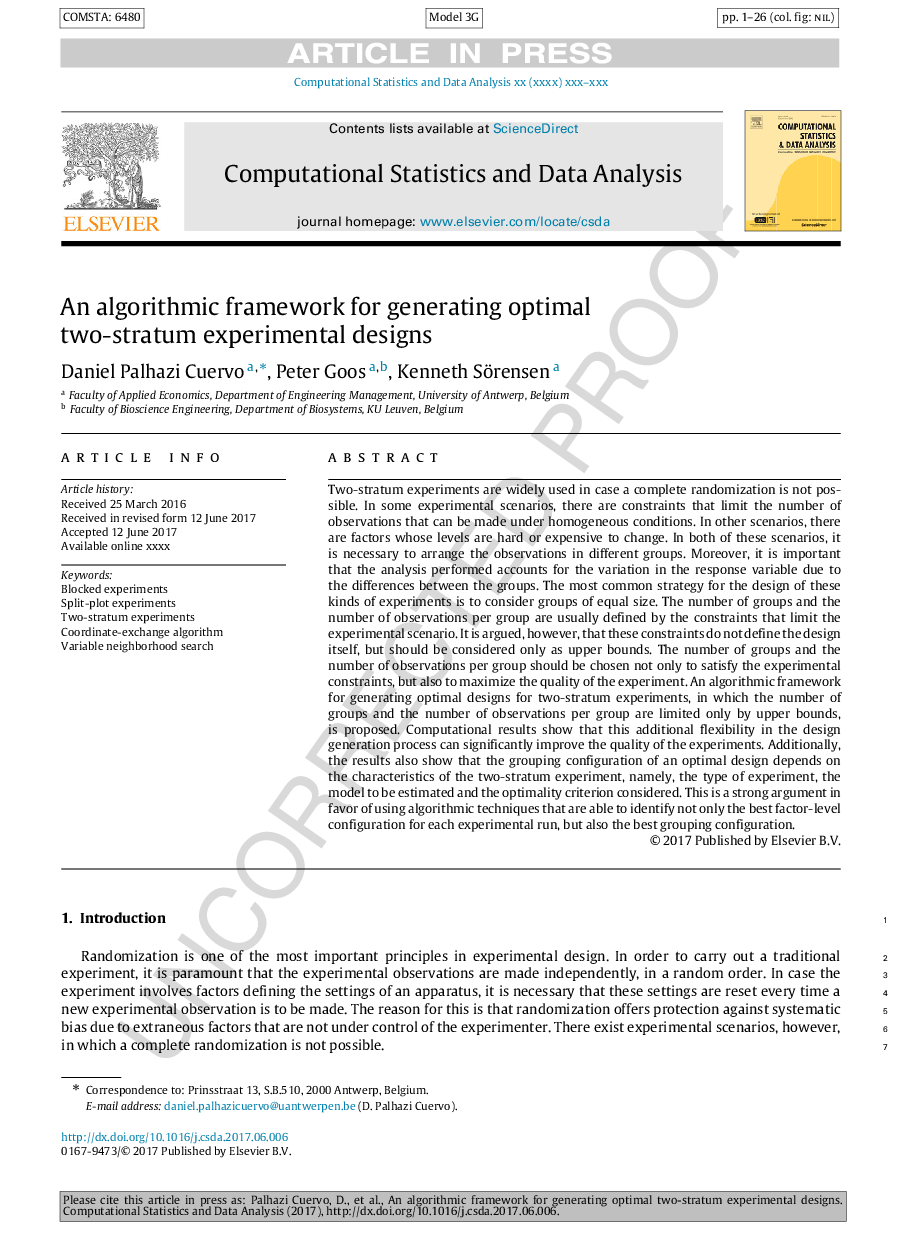| کد مقاله | کد نشریه | سال انتشار | مقاله انگلیسی | نسخه تمام متن |
|---|---|---|---|---|
| 4949231 | 1440041 | 2017 | 26 صفحه PDF | دانلود رایگان |
عنوان انگلیسی مقاله ISI
An algorithmic framework for generating optimal two-stratum experimental designs
ترجمه فارسی عنوان
یک چارچوب الگوریتمی برای تولید طرح های آزمایشی بهینه دو ستاره
دانلود مقاله + سفارش ترجمه
دانلود مقاله ISI انگلیسی
رایگان برای ایرانیان
کلمات کلیدی
آزمایش های مسدود شده، آزمایشات تقسیم شده، دو آزمایش آزمایشگاهی، الگوریتم هماهنگی مبادله، متغیر جستجوی محله،
ترجمه چکیده
آزمایشات دو مرحله ای به طور گسترده ای در صورت تصادف کامل امکان پذیر نیست. در برخی از سناریوهای تجربی، محدودیت هایی وجود دارد که تعداد مشاهداتی را که می توان در شرایط همگانی ایجاد کرد، محدود می کند. در سایر شرایط، عوامل وجود دارد که سطح آنها سخت یا گران است برای تغییر. در هر دو این سناریو، مشاهدات در گروه های مختلف ضروری است. علاوه بر این مهم است که تجزیه و تحلیل انجام شده برای تغییرات متغیر پاسخ به دلیل تفاوت بین گروه ها حساب می شود. شایع ترین استراتژی برای طراحی این نوع آزمایش ها این است که گروه ها را با اندازه برابر مقایسه کنیم. تعداد گروه ها و تعداد مشاهدات در هر گروه معمولا توسط محدودیت هایی که سناریوی تجربی را محدود می کنند تعریف می شود. با این حال استدلال می شود که این محدودیت ها طراحی خود را تعریف نمی کنند، بلکه باید فقط به عنوان مرز بالایی در نظر گرفته شوند. تعداد گروه ها و تعداد مشاهدات در هر گروه باید نه تنها برای برآورد محدودیت های تجربی، بلکه همچنین برای به حداکثر رساندن کیفیت آزمایش. یک چارچوب الگوریتمی برای تولید طرح های بهینه برای آزمایش های دو طبقه که تعداد آنها در تعداد گروه ها و تعداد مشاهدات در هر گروه محدود است و تنها محدودیت های بالاتری است. نتایج محاسباتی نشان می دهد که این انعطاف پذیری بیشتر در فرایند تولید طراحی می تواند به طور قابل توجهی کیفیت آزمایش ها را بهبود بخشد. علاوه بر این، نتایج همچنین نشان می دهد که پیکربندی گروه بندی یک طراحی بهینه، به ویژگی های آزمایش دو طبقه بستگی دارد، یعنی نوع آزمایش، مدل تخمینی و معیار بهینه سازی در نظر گرفته شده است. این استدلال قوی در استفاده از تکنیک های الگوریتمی است که می توانند نه تنها بهترین پیکربندی سطح فاکتور را برای هر آزمایش آزمایشی، بلکه بهترین پیکربندی گروه بندی را شناسایی کنند.
موضوعات مرتبط
مهندسی و علوم پایه
مهندسی کامپیوتر
نظریه محاسباتی و ریاضیات
چکیده انگلیسی
Two-stratum experiments are widely used in the event a complete randomization is not possible. In some experimental scenarios, there are constraints that limit the number of observations that can be made under homogeneous conditions. In other scenarios, there are factors whose levels are hard or expensive to change. In both of these scenarios, it is necessary to arrange the observations in different groups. Moreover, it is important that the analysis performed accounts for the variation in the response variable due to the differences between the groups. The most common strategy for the design of these kinds of experiments is to consider groups of equal size. The number of groups and the number of observations per group are usually defined by the constraints that limit the experimental scenario. It is argued, however, that these constraints do not define the design itself, but should be considered only as upper bounds. The number of groups and the number of observations per group should be chosen not only to satisfy the experimental constraints, but also to maximize the quality of the experiment. An algorithmic framework for generating optimal designs for two-stratum experiments, in which the number of groups and the number of observations per group are limited only by upper bounds, is proposed. Computational results show that this additional flexibility in the design generation process can significantly improve the quality of the experiments. Additionally, the results also show that the grouping configuration of an optimal design depends on the characteristics of the two-stratum experiment, namely, the type of experiment, the model to be estimated and the optimality criterion considered. This is a strong argument in favor of using algorithmic techniques that are able to identify not only the best factor-level configuration for each experimental run, but also the best grouping configuration.
ناشر
Database: Elsevier - ScienceDirect (ساینس دایرکت)
Journal: Computational Statistics & Data Analysis - Volume 115, November 2017, Pages 224-249
Journal: Computational Statistics & Data Analysis - Volume 115, November 2017, Pages 224-249
نویسندگان
Daniel Palhazi Cuervo, Peter Goos, Kenneth Sörensen,
